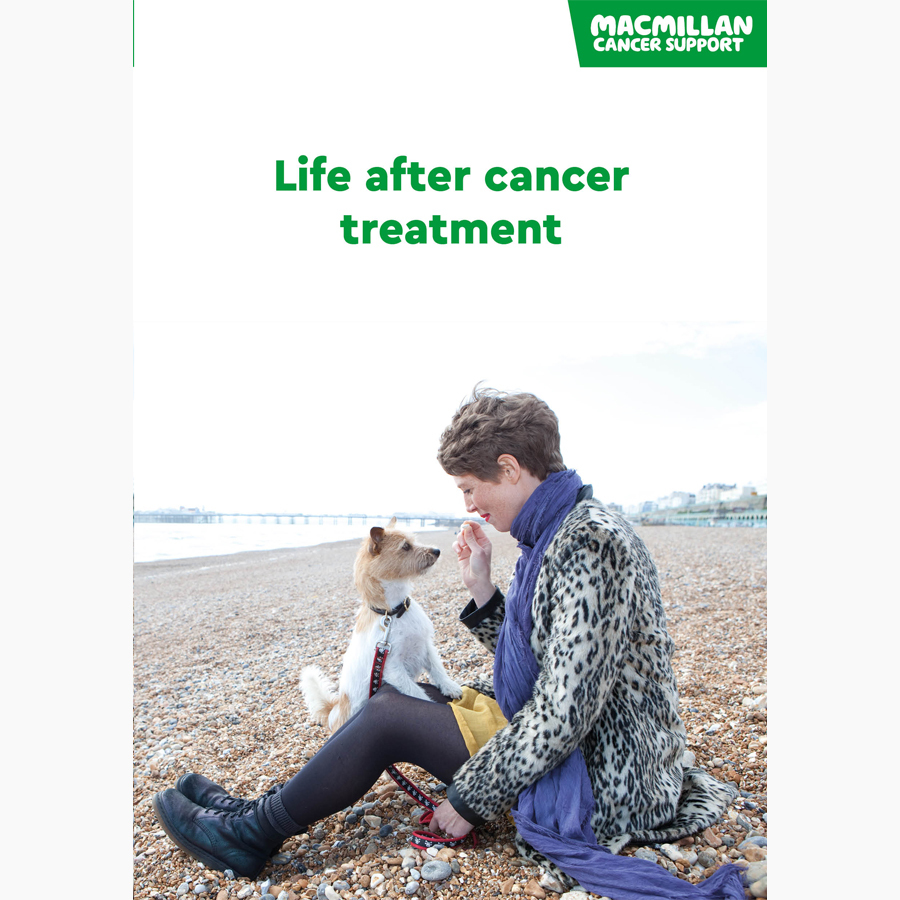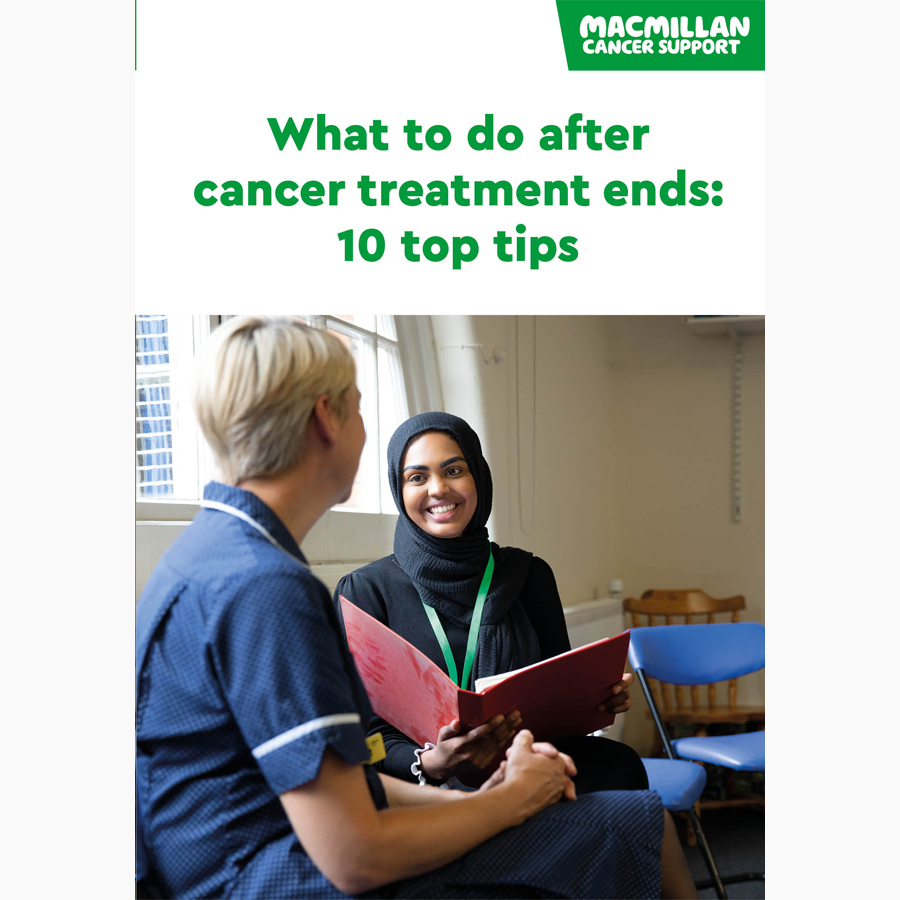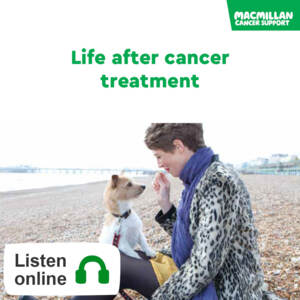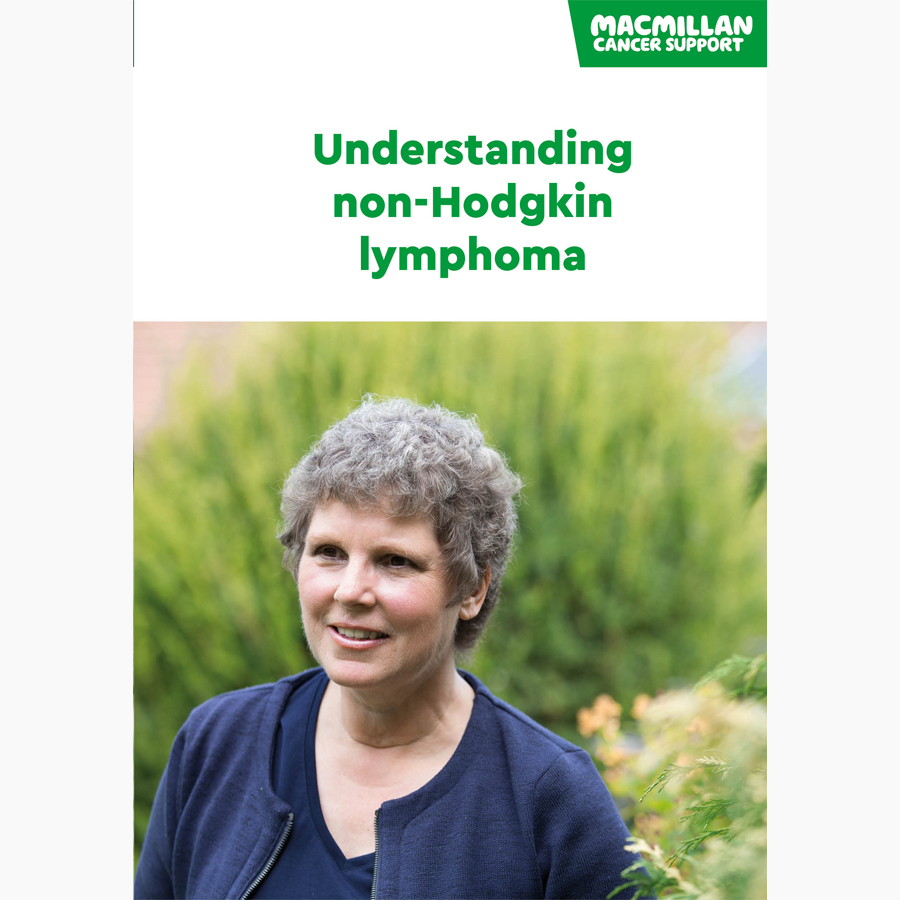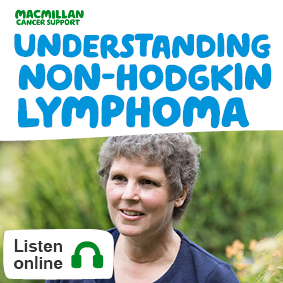Non-Hodgkin lymphoma (NHL)
Choose a type
On this page
-
What is non-Hodgkin lymphoma (NHL)?
-
Symptoms of non-Hodgkin lymphoma (NHL)
-
Causes of non-Hodgkin lymphoma (NHL)
-
Diagnosis of non-Hodgkin lymphoma (NHL)
-
Types of non-Hodgkin lymphoma (NHL)
-
Stage and grade of non-Hodgkin lymphoma (NHL)
-
Treatment for non-Hodgkin lymphoma (NHL)
-
After non-Hodgkin lymphoma (NHL) treatment
-
Access our lymphoma information in other formats
-
About our information
-
How we can help
What is non-Hodgkin lymphoma (NHL)?
Non-Hodgkin lymphoma (NHL) is a cancer of the lymphatic system. This is the system that helps protect your body from infection and disease.
The most common symptom of non-Hodgkin lymphoma is a painless swelling in the neck, armpit or groin.
Some types of NHL grow very slowly and may not need treatment for months or years. Other types grow quickly and need treatment soon after diagnosis.
NHL is the sixth most common cancer in the UK. Around 14,000 people are diagnosed with it each year. It can affect people at any age but is more common as people get older. Most people diagnosed with NHL are over 55.
Non-Hodgkin lymphoma is 1 of 2 main types of lymphoma. The other type is called Hodgkin lymphoma. How lymphoma develops and the treatment you may need depends on the type of lymphoma.
For healthcare professionals
If you are a healthcare professional, use our guide to find the right information and support for your patients affected by lymphoma. This explains the support available from Macmillan and from other trusted organisations.
Symptoms of non-Hodgkin lymphoma (NHL)
The most common symptom of lymphoma is a painless swelling in the lymph nodes in the neck, armpit or groin.
We have more information about the signs and symptoms of lymphoma.
Related pages
Causes of non-Hodgkin lymphoma (NHL)
The causes of non-Hodgkin lymphoma are mostly unknown. But some things may increase your risk of developing it. These are called risk factors.
We have more information about causes and risk factors for NHL.
Diagnosis of non-Hodgkin lymphoma (NHL)
If you have symptoms, you usually start by seeing your GP. If they think your symptoms could be caused by cancer, they may arrange for you to have blood tests or scans. Your doctor will refer you to hospital for tests and for specialist advice and treatment.
If you think you may be pregnant, tell your doctor. Some tests and treatments for lymphoma can be harmful to a baby in the womb. If you are pregnant you usually still have tests and treatment for lymphoma. But it is important to talk to your doctor so they can plan your care safely.
Biopsy for lymphoma
The most common test for diagnosing lymphoma is a biopsy. A doctor will take a sample of tissue from the affected area. The most common place to take a biopsy from is an enlarged lymph node. This is called a lymph node biopsy. You may have all or a part of the lymph node removed. The tissue will be sent to a laboratory for testing. You may also have biopsies taken from other areas of your body.
You can find out more about further tests you may have in our information about non-Hodgkin lymphoma.
Waiting for test results can be difficult. You may find it helpful to talk to your family, friends or specialist nurse.
Related pages
Further tests for lymphoma
You will have more tests before you start treatment for lymphoma. Some tests help to show the stage of the lymphoma.
You may have other tests, such as blood tests or x-rays to check your general health and how well your heart, lungs, liver and kidneys are working.
For example, your doctor will do blood tests to check the levels of different blood cells in your blood. They may also talk to you about having blood tests to check for certain viruses, such as HIV and hepatitis.
You may have some of the following tests.
-
CT scan
A CT scan makes a three-dimensional (3D) picture of the inside of the body using x-rays taken by the CT scanner.
-
Ultrasound
An ultrasound uses sound waves to build up a picture of internal organs. It can be used to guide a biopsy. The scan helps to guide them to the exact area.
-
PET-CT scan
A PET-CT scan uses low-dose radiation to check the activity of cells in different parts of the body. It is sometimes given together with a CT scan. This is called a PET-CT scan.
-
MRI scan
An MRI scan uses magnetism to build up a detailed picture of areas of your body.
-
Bone marrow sample
A small sample of bone marrow is taken from the back of the hip bone (pelvis). The sample is sent to a laboratory to be checked for abnormal cells.
-
Lumbar puncture
In some types of non-Hodgkin lymphoma, the lymphoma cells may get into this fluid. A lumbar puncture takes a sample of the fluid that surrounds the brain and spinal cord.
Waiting for test results can be a difficult time, we have more information that can help.
Types of non-Hodgkin lymphoma (NHL)
There are many different types of NHL. Your doctors need to know which type you have so they can give you the best treatment.
We have more information about the different types of NHL.
Stage and grade of non-Hodgkin lymphoma (NHL)
The results of your tests help your doctors find out how many areas of the body are affected by lymphoma and where these areas are. This is called staging.
Lymphomas are also grouped as either low-grade or high-grade.
We have more information about staging and grading of non-Hodgkin lymphoma.
Treatment for non-Hodgkin lymphoma (NHL)
A team of specialists will meet to discuss the best possible treatment for you. This is called a multidisciplinary team (MDT).
There are different types of treatment for NHL. You may need just one type of treatment or a combination of treatments.
Your doctor or cancer specialist or nurse will explain the different treatments and their side effects. They will also talk to you about things to consider when making treatment decisions.
Treating lymphoma will depend on:
- the type of lymphoma
- and the stage and grade of the lymphoma.
Types of treatment you may have include:
-
Watch and wait
During watch and wait, you do not need to start treatment straight away. Instead, you have regular tests and appointments to monitor the lymphoma and check for signs that you need to start treatment.
-
Chemotherapy
Chemotherapy is often used to treat lymphoma. It uses anti-cancer (cytotoxic) drugs to destroy lymphoma cells. You can have chemotherapy with steroids and targeted therapy drugs.
-
Steroids
Steroids are drugs given with chemotherapy to help treat lymphoma.
-
Targeted therapies
Targeted therapies target specific proteins on cells and also encourage the body’s immune system to attack and destroy lymphoma cells. They are given with chemotherapy (called chemoimmunotherapy) or on their own.
-
Radiotherapy
Radiotherapy treats cancer by using high-energy rays that destroy cancer cells, while doing as little harm as possible to normal cells. It may be used as the only treatment if you have early stage low grade NHL.
-
Stem cell transplant
Some people may have a stem cell transplant. A stem cell transplant is an intensive treatment, so it is not suitable for everyone. You may have a transplant using:
- your own stem cells (autologous stem cell transplant)
- cells from a donor (allogeneic stem cell transplant).
We have more information about treating non-Hodgkin lymphoma.
You may have some treatments as part of a clinical trial.
After non-Hodgkin lymphoma (NHL) treatment
People often have many different feelings when they finish lymphoma treatment. You may feel relieved that treatment has finished, but worried about what will happen in the future.
You will have appointments with your lymphoma doctor or nurse less often than before. But at the same time, you may have new challenges to cope with and things to think about.
We have information below about some of the things people ask about after lymphoma treatment. But you may have other questions or need information about something else. If there is something you want to talk about at any point after treatment, you can:
- call the Macmillan Support Line free on 0808 808 00 00
- chat to our specialists online
- visit our Online Community to talk to people who have been affected by lymphoma, share your experience, and ask an expert your questions.
Related pages
Other organisations who offer information and support
The organisations below also offer information and support:
-
Blood Cancer UK
Blood Cancer UK offers support and information to people affected by blood cancers, including lymphoma.
-
Lymphoma Action
Lymphoma Action provides high quality information and support for people affected by lymphoma. It provides helpline services and a range of peer support including online support meetings, educational events and webinars. Its website includes TrialsLink, a database of lymphoma clinical trials.
Lymphoma follow-up
Related pages
Side effects of lymphoma treatment
You may have some ongoing side effects as you recover from lymphoma treatment. You can use our impacts of cancer A-Z to search for information about managing different symptoms and side effects. Or find out more about side effects of treatment for Hodgkin lymphoma or treatment for non-Hodgkin lymphoma.
-
Tiredness and fatigue
Tiredness (fatigue) often affects people with cancer. It can be caused by lymphoma or be a side effect of lymphoma treatment. RESTORE is an online resource that aims to help people living with cancer related fatigue.
-
Sexual well-being
Lymphoma and its treatment can sometimes affect your sex life. There are ways to improve your sexual well-being and to manage any problems.
-
Fertility
Treatment for lymphoma may affect your fertility. If you are worried about your fertility it is important to talk with your doctor before you start treatment. We have more information about:
Sometimes side effects may continue or develop months or years after treatment. These are called late effects. We have more information about long-term and late effects of treatment for lymphoma.
Well-being and recovery
It can take time to recover after lymphoma treatment. Some days you may feel better than others.
It is important to know where to get support or information if you need it. People often need support even some time after lymphoma treatment. But sometimes it is difficult to know who to ask for help. To find support:
- ask your GP or someone from your cancer team for advice about support in your area
- search cancercaremap.org to find cancer support services near you
- call us free on 0808 808 0000 or talk to us online - our cancer information and support specialists can offer guidance and help you find what you need.
Our course Help to Overcome Problems Effectively (HOPE) helps people during and after cancer treatment. It is a free, interactive, group based, self management support course. It runs for 6 weeks, with each weekly session lasting 2.5 hours. To find out more about HOPE courses in your area, email ServiceOpsSupport@macmillan.org.uk
A healthy lifestyle can help speed up your recovery. Even small lifestyle changes may improve your well-being and long-term health.
Related pages
Booklets and resources
Other useful information
Access our lymphoma information in other formats
We are working to make our website as accessible as possible. We want everyone to be able to use it to find the information they need. We have tips about using settings on your computer or device to help you use our website in our accessibility statement.
We also provide information in a range of languages and formats. If you cannot find the information you are looking for in the format or language you need, email us at cancerinformationteam@macmillan.org.uk
Order our non-Hodgkin lymphoma booklet
Download our lymphoma booklet and ebooks
Our Understanding non-Hodgkin lymphoma booklet is available as a pdf to download or view online and in ePub or Mobi formats to download.
Booklets and resources
Listen to our lymphoma audiobook
You can listen to our Understanding non-Hodgkin lymphoma audiobook. You can also search our full range of audiobooks.
Booklets and resources
Find non-Hodgkin lymphoma information in your language
We have a range of translated cancer information. This includes information about different cancer types, being diagnosed, cancer treatment, and side effects. We have some lymphoma information in the following languages. You can also search our most up to date list of web pages we have translated on request.
- Bulgarian - Mantle cell lymphoma / Мантелноклетъчен лимфом [PDF]
- German - Follicular lymphoma / Follikuläres Lymphom (FL) [PDF]
- Polish - Diffuse large B-cell lymphoma (DLBCL) / Chłoniak rozlany z dużych komórek B [PDF]
- Polish - Lymphoma / Chłoniak [PDF]
- Slovak - Anaplastic large cell lymphoma (ALCL) / Anaplastický veľkobunkový lymfóm [PDF]
- Slovak - Follicular lymphoma / Folikulový lymfóm [PDF]
- Tamil - Follicular lymphoma [PDF]
If you would like any of our lymphoma information translated into your language, please email cancerinformationteam@macmillan.org.uk
Watch British sign language videos
You can watch our BSL videos about cancer on YouTube.
Find our easy read booklets
Our easy read booklets use simple words and pictures to tell you about cancer. They can be useful if you want information that is easier to understand.
Looking for large print, Braille or another format?
If you would like our information in a different format such as large print or Braille, email us at cancerinformationteam@macmillan.org.uk or call us free on 0808 808 00 00.
About our information
-
References
Below is a sample of the sources used in our non-Hodgkin lymphoma (NHL) information. If you would like more information about the sources we use, please contact us at cancerinformationteam@macmillan.org.uk
National Institute of Health and Care Excellence (NICE). Blood and bone marrow cancers. NICE Pathways. Last accessed 3 December 2020.
Non-Hodgkin’s lymphoma: diagnosis and management; NICE Guideline (July 2016).
Newly Diagnosed and Relapsed Follicular Lymphoma: ESMO Clinical Practice Guidelines for diagnosis, treatment and follow-up; European Society for Medical Oncology (2020).
-
Reviewers
This information has been written, revised and edited by Macmillan Cancer Support’s Cancer Information Development team. It has been reviewed by expert medical and health professionals and people living with cancer. It has been approved by Senior Medical Editor, Professor Rajnish Gupta, Macmillan Consultant Medical Oncologist.
Our cancer information has been awarded the PIF TICK. Created by the Patient Information Forum, this quality mark shows we meet PIF’s 10 criteria for trustworthy health information.
Date reviewed
This content is currently being reviewed. New information will be coming soon.

Our cancer information meets the PIF TICK quality mark.
This means it is easy to use, up-to-date and based on the latest evidence. Learn more about how we produce our information.
How we can help



